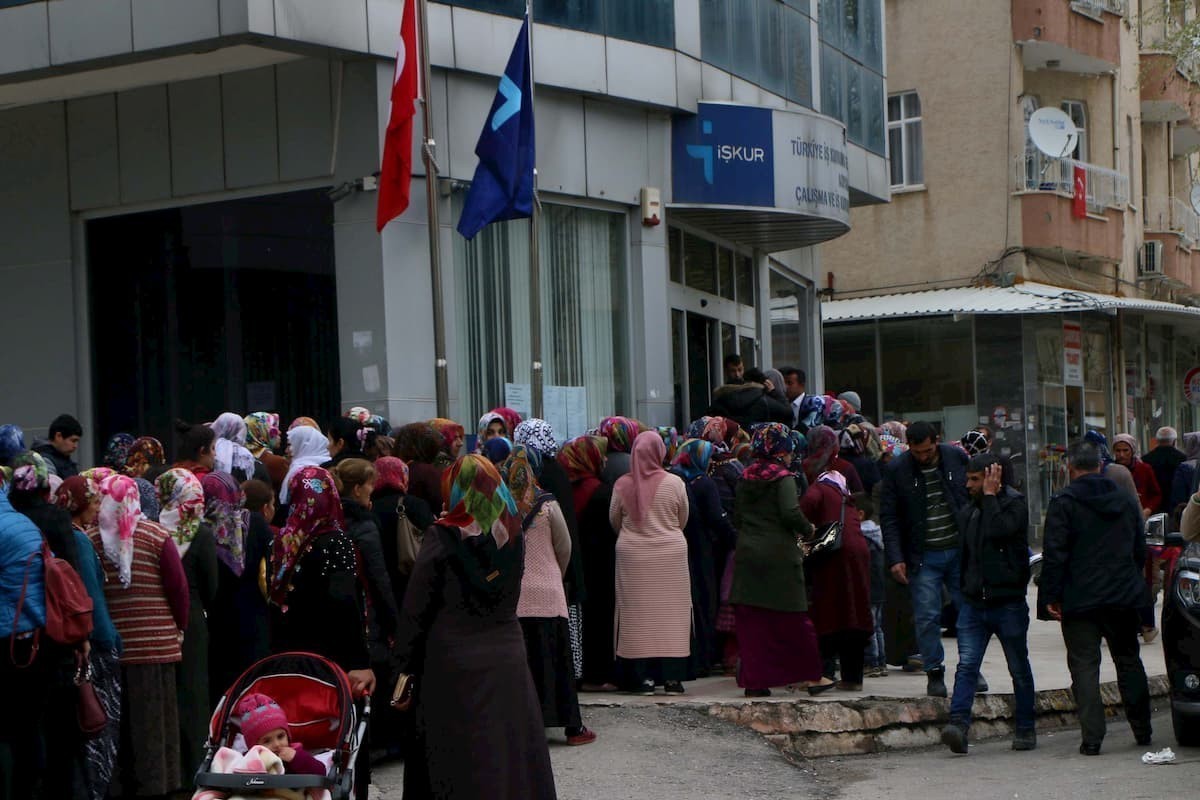Unemployment in Turkey remains at peak levels: 14.7%
Unemployment in Turkey stood at 14.7% in February 2019. With unemployment rising by 4.1 percentage points against the same period last year, it remained constant compared to January.

Fotoğraf: DHA
The Turkish Statistical Institute (TurkStat) has released the February unemployment figures. TurkStat figures put unemployment steady at 14.7% as against January levels. Unemployment in Turkey peaked at 14.8% in February 2009 under the influence of the last international crisis.
In Turkey as a whole, the number of unemployed aged 15 and above rose by 1.376 million to 4.73 million in February 2019 as against the same period last year. Unemployment clocked in at 14.7%, rising by 4.1 percentage points as against the same month last year. Non-agricultural unemployment in the same period is estimated to be 16.9%, having increased by 4.4%. With unemployment among young people (15-24 age) rising 7.1% to 26.1%, the corresponding figure for the 15-64 age group was 15.0% with a percentage-point rise of 4.1.
811,000 EXCLUDED FROM EMPLOYMENT
With an 811,000 reduction in the number of employed in February 2019 as against the same period last year to 27.355 million, in percentage terms the employment rate was 44.8%, falling by 1.8 points.
In this period, the number employed in the agricultural sector fell by 296,000, while the number employed in the non-agricultural sector did so by 514,000. Of those in employment, 17.1% came within the agricultural, 19.7% the industrial, 5.4% the construction and 57.7% the service sector. Compared on a like-for-like basis with last year, with the share of those employed in the agricultural sector falling by 0.6 percentage points, those employed in the industrial sector by 0.3 points and in the construction sector by 1.6 points, the share of the service sector increased by 2.4 points.
WORKFORCE PARTICIPATION RATE 52.5%
With the workforce increasing by 564,000 to 32.84 million in February compared to the same period last year, the workforce participation rate registered a 0.3 percentage point increase to 52.5%. Compared on a like-for-like basis, the workforce participation rate among men fell by 0.1 of a percentage point to 71.4%, while that among women rose by 0.7 of a percentage point to 34.0%
ONE IN THREE WORKERS UNRECORDED
The percentage of those working unattached to any social security institution in the February 2019 period rose by 1.3 percentage points against the same period in the previous year to 33.5%. As to the rate of unrecorded workers in the non-agricultural sector, this rose by 1.1 points as against the same period last year to 22.8%.
Seasonally adjusted employment rose by 68,000 against the previous period to 28.85 million. The corresponding employment rate rose by 0.1 of a percentage point to 46.0%.
As to seasonally adjusted unemployment, this rose by 113,000 against the previous period to 4.417 million. The corresponding unemployment rate increased by 0.3 of a percentage point to 13.6%.
The seasonally adjusted workforce participation rate rose by 0.2 points to 53.2%. With the number of employed by economic activity falling by 23,000 in the agricultural sector, 4,000 in the industrial sector and 14,000 in the construction sector, it rose by 108,000 in the service sector.
WHAT DO ECONOMISTS SAY?
The unemployment figures released by TurkSat have elicited comments from economists:
Ümit Akçay: Unemployment hits poorly educated segments harder. The fields highlighted in yellow in the following table show segments in which unemployment has risen by more than five points. The “illiterate” and “vocational or technical high school graduates” are the segments most affected.
Prof. Veysel Ulusoy: A two percentage point fall in industrial production in the Turkish economy corresponds on average to 300,000 unemployed. This, in turn, amounts to at least a one per cent increase in unemployment figures. We cannot see this in the figures.
Mustafa Sönmez: TurkStat showed January unemployment remaining constant in February. The rate of 14.7% was 14.7% in January. The figure was shown as rising from 4.668 million to 4.73 million, that’s all. The forecasts were for record-level unemployment of 15%. Seasonally adjusted unemployment increased according to TurkStat from 13.3% to 13.6%. Non-agricultural unemployment, conversely, rose from 15.5% to 15.8%. According to TurkStat, seasonally adjusted unemployment rose but it remained unchanged when unadjusted.
AĞBABA: UNEMPLOYMENT CANNOT BE SOLVED UNLESS THE SINGLE-MAN REGIME CHANGES
For his part, CHP Deputy General Chair Veli Ağbaba had the following take on the unemployment figures released by TurkStat: “Neither the unemployment problem nor the economic crisis can be solved unless AKP rule and the single-man regime changes.”
Saying that Turkey was undergoing one of the biggest economic crises of its history in which high inflation, on the one hand, was combined with high unemployment on the other, said, “Stagnation and contraction in the economy accompany high unemployment and inflation rates. The New Economic Programme that the son-in-law Minister announced in September continues to go bust with each passing month, or indeed with each passing day. Those in quest of sultanate and office have no qualms about pushing the country to the edge of the precipice.”
“ALBAYRAK’S NEW ECONOMIC PROGRAMME HAS CRUMBLED”
Also pointing to the rise in youth unemployment figures, Ağbaba said, “The son-in-law Minister’s 12.1% unemployment forecast for 2019 has long since gone up in smoke, and both Berat Albayrak’s New Economic Programme and his structural reforms have also long since crumbled.” Recalling that, while during the two biggest economic crises in Turkey’s history of 1994 and 2001 unemployment rates were at 9%, Ağbaba said, “In one sense, our country has been dragged into the biggest economic crisis of the country’s history under the AKP and the single-man regime. Until AKP rule and the single-man regime change, there is no chance of solving the unemployment problem.”
Ağbaba underlined that, according to the OECD, Turkey was the second-ranking member country after Greece for its unemployment rate among the active population. (EVRENSEL DAILY)
Forwarding to the next article...
10 seconds remaining





Follow Evrensel